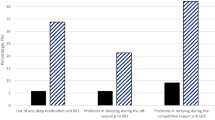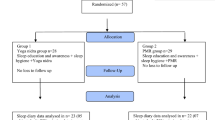Abstract
Purpose
Sleep is an important factor for sports performance. Physiological delay in sleep–wake phase and sports training pose adolescent athletes at increased risk of sleep problems. The aim of the study was to observe the sleep pattern and effect of non-pharmacological sleep strategies in adolescent archers.
Methods
Fifteen male adolescent archers participated. Sleep measures were recorded using ‘School Sleep Habits Survey’ questionnaire. Awareness of benefits of good sleep on recovery in sports was done for coaches, staff and players. Institution of a sleep consultation and practice of non-pharmacological strategies to improve sleep for players was carried out for a year. Sleep measures and archery scores were analysed.
Results
Sleep pattern showed delayed sleep onset and decreased sleep duration. Post-intervention, total sleep duration increased during weekdays and weekends and sleep onset latency significantly reduced during weekdays (p = 0.008). Archery practice shooting score over the year significantly improved (p = 0.018).
Conclusions
Sleep in adolescent archers showed altered sleep parameters. Self-awareness and sleep hygiene education of coaches and players along with non-pharmacological interventions showed a significant improvement in sleep and archery performance.
Clinical trial registration ID
CTRI/2017/05/008676.
Similar content being viewed by others
References
Kim H-B, Kim S-H, So W-Y. The relative importance of performance factors in Korean archery. J Strength Cond Res. 2015;29:1211–9.
Ergen E, Hibner K, editors. Sports medicine and science in archery - II. FITA Medical and Sports Sciences Committee. Turkey: Hacettepe University Hospitals Publishing House; 2008.
Robazza C, Bertollo M, Filho E, Hanin Y, Bortoli L. Perceived control and hedonic tone dynamics during performance in elite shooters. Res Q Exerc Sport. 2016;87:284–94.
Chen Y-C, Hung T-M. Effects of pre-competition cognitive anxiety on attention and emotion during archery performance. Int J Psychophysiol. 2010;3:268.
Robazza C, Bortoli L, Nougier V. Emotions, heart rate and performance in archery. J Sports Med Phys Fitness. 1999;39:169–76.
Behan M, Wilson M. State anxiety and visual attention: the role of the quiet eye period in aiming to a far target. J Sports Sci. 2008;26:207–15.
Robazza C, Bortoli L, Nougier V. Physiological arousal and performance in elite archers: a field study. Eur Psychol. 1998;3:263.
Long-Term Archer Development Model|Archery Canada Tir à l’Arc. http://www.archerycanada.ca/en/ltadm/long-term-archer-development-model. Accessed 10 Aug 2018.
Crowley SJ, Wolfson AR, Tarokh L, Carskadon MA. An update on adolescent sleep: new evidence informing the perfect storm model. J Adolesc. 2018;67:55–65.
Pujalte GGA, Benjamin HJ. Sleep and the athlete. Curr Sports Med Rep. 2018;17:109–10.
Carskadon MA. Sleep in adolescents: the perfect storm. Pediatr Clin. 2011;58:637–47.
Bergeron MF, Mountjoy M, Armstrong N, Chia M, Côté J, Emery CA, Faigenbaum A, Hall G, Kriemler S, Léglise M. International Olympic Committee consensus statement on youth athletic development. Br J Sports Med. 2015;49:843–51.
Paruthi S, Brooks LJ, D’Ambrosio C, et al. Recommended amount of sleep for pediatric populations: a consensus statement of the American Academy of Sleep Medicine. J Clin Sleep Med. 2016;12:785–6.
Drew M, Vlahovich N, Hughes D, et al. Prevalence of illness, poor mental health and sleep quality and low energy availability prior to the 2016 Summer Olympic Games. Br J Sports Med. 2018;52:47–53.
Mah CD, Kezirian EJ, Marcello BM, Dement WC. Poor sleep quality and insufficient sleep of a collegiate student-athlete population. Sleep Health. 2018;4:251–7.
Richardson C, Micic G, Cain N, Bartel K, Maddock B, Gradisar M. Cognitive performance in adolescents with delayed sleep-wake phase disorder: treatment effects and a comparison with good sleepers. J Adolesc. 2018;65:72–84.
May KN, Razak NA. Relationship between sleep and mood states among student-athlete of Majlis Sukan Negeri (MSN), Perak. J Fundam Appl Sci. 2017;9:1346–54.
Kirschen GW, Jones JJ, Hale L. The impact of sleep duration on performance among competitive athletes: a systematic literature review. Clin J Sport Med. 2018. https://doi.org/10.1097/JSM.0000000000000622.
Sawczuk T, Jones B, Scantlebury S, Till K. The influence of training load, exposure to match play and sleep duration on daily wellbeing measures in youth athletes. J Sports Sci. 2018;36:2431–7.
Yadav N, Kumar A, Mahajan U, Datta K. Post-intense exercise sleep concerns in weightlifters: a pilot study. Med J Armed Forces India. 2018. https://doi.org/10.1016/j.mjafi.2018.09.005.
Suppiah HT, Yong LC, Chia M. OC12 snooze to win— a preliminary investigation into the effects of sport-training on asian adolescent-athlete sleep patterns. Br J Sports Med. 2014;48:A4–5.
Olds T, Blunden S, Petkov J, Forchino F. The relationships between sex, age, geography and time in bed in adolescents: a meta-analysis of data from 23 countries. Sleep Med Rev. 2010;14:371–8.
Suppiah HT (2017) Adolescent-athlete sleep and sport performance. PhD Thesis.
Nedelec M, Aloulou A, Duforez F, Meyer T, Dupont G. The variability of sleep among elite athletes. Sports Med Open. 2018;4:34.
Whitworth-Turner C, Di Michele R, Muir I, Gregson W, Drust B. A comparison of sleep patterns in youth soccer players and non-athletes. Sci Med Footb. 2018;2:3–8.
Datta K, Kumar A, Guru C. Enhancement of performance in an elite archer following non pharmacological intervention to improve sleep: a case report. Med J Armed Forces India. 2018. https://doi.org/10.1016/j.mjafi.2018.06.010.
Laverack G. The challenge of behaviour change and health promotion. Challenges. 2017;8:25.
Cohen J. A power primer. Psychol Bull. 1992;112:155.
The sleep for science program. http://www.sleepforscience.org/. Accessed 17 Aug 2018.
Carskadon MA. Adolescent sleep patterns: Biological, social, and psychological influences. Cambridge: Cambridge University Press; 2002.
Singh R, Suri JC, Sharma R, Suri T, Adhikari T. Sleep pattern of adolescents in a School in Delhi, India: impact on their mood and academic performance. India: Indian J Pediatr; 2018. https://doi.org/10.1007/s12098-018-2647-7.
Rulebook. In: World Archery. https://worldarchery.org/rulebook. Accessed 11 Aug 2018.
Harsora P, KessMann J. Nonpharmacologic management of chronic insomnia. Am Fam Physician. 2009;79:125–30.
Siebern AT, Suh S, Nowakowski S. Non-pharmacological treatment of insomnia. Neurotherapeutics. 2012;9:717–27.
Morin CM. Insomnia: psychological assessment and management. New York: Guilford Press; 1993.
Morin CM, Colecchi C, Stone J, Sood R, Brink D. Behavioral and pharmacological therapies for late-life insomnia: a randomized controlled trial. JAMA. 1999;281:991–9.
Watson NF, Martin JL, Wise MS, Carden KA, Kirsch DB, Kristo DA, Malhotra RK, Olson EJ, Ramar K, Rosen IM, Rowley JA, Weaver TE, Chervin RD. Delaying middle school and high school start times promotes student health and performance: an American Academy of Sleep Medicine position statement. J Clin Sleep Med. 2017;13(4):623–5.
Galland BC, Short MA, Terrill P, Rigney G, Haszard JJ, Coussens S, Foster-Owens M, Biggs SN. Establishing normal values for pediatric nighttime sleep measured by actigraphy: a systematic review and meta-analysis. Sleep. 2018;41:zsy017.
Hirshkowitz M, Whiton K, Albert SM, Alessi C, Bruni O, DonCarlos L, Hazen N, Herman J, Katz ES, Kheirandish-Gozal L. National Sleep Foundation’s sleep time duration recommendations: methodology and results summary. Sleep Health. 2015;1:40–3.
Suppiah HT, Low CY, Chia M. Effects of sport-specific training intensity on sleep patterns and psychomotor performance in adolescent athletes. Pediatr Exerc Sci. 2016;28:588–95.
Melbourne University Sport. http://www.sport.unimelb.edu.au/eliteathleteprogram. Accessed 18 Aug 2018.
Short MA, Gradisar M, Wright H, Lack LC, Dohnt H, Carskadon MA. Time for bed: parent-set bedtimes associated with improved sleep and daytime functioning in adolescents. Sleep. 2011;34:797–800.
Chervin RD. Use of clinical tools and tests in sleep medicine. Principles and practice of sleep medicine. 4th ed. Philadelphia: Elsevier; 2005. p. 602–14.
Weitzman ED, Czeisler CA, Coleman RM, Spielman AJ, Zimmerman JC, Dement W, Pollak CP. Delayed sleep phase syndrome: a chronobiological disorder with sleep-onset insomnia. Arch Gen Psychiatry. 1981;38:737–46.
Fullagar HHK, Skorski S, Duffield R, Hammes D, Coutts AJ, Meyer T. Sleep and athletic performance: the effects of sleep loss on exercise performance, and physiological and cognitive responses to exercise. Sports Med. 2015;45:161–86.
Acknowledgements
All athletes, coaches and administrators of Army Sports Institute, Pune, India are acknowledged for their active contribution in the study.
Funding
This research did not receive any specific grant from funding agencies in the public, commercial, or not-for-profit sectors.
Author information
Authors and Affiliations
Corresponding author
Ethics declarations
Conflict of Interest
The authors declare that they have no conflict of interest.
Additional information
Publisher's Note
Springer Nature remains neutral with regard to jurisdictional claims in published maps and institutional affiliations.
Rights and permissions
About this article
Cite this article
Guru, C.S., Datta, K., Krishnan, A. et al. Sleep Pattern and Sports Performance of Adolescent Archers: A Pre–Post-intervention Pilot Study. Sleep Vigilance 3, 143–149 (2019). https://doi.org/10.1007/s41782-019-00073-5
Received:
Revised:
Accepted:
Published:
Issue Date:
DOI: https://doi.org/10.1007/s41782-019-00073-5




